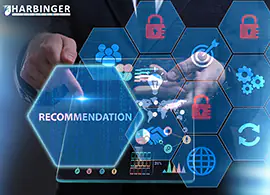
Think about the brick and mortar business; the shopkeepers knew their customers so well. What has the customer purchased in the past, what are their seasonal purchases, what are the quantities in which the purchase happens, everything is known to them. Based on their knowledge, the shopkeepers would recommend a commodity to the customers, which they mostly ended up buying. To come to think of it, the web and mobile applications do the same with something called ‘Recommendation systems’ or also known as ‘Recommendation Engines.’ Simply put, a recommender system is a system that can predict the future preference of a set of items for a user and recommend the top things. Name any application Netflix, Amazon, Google all of them use recommendation systems.
HR Tech encompasses different applications such as recruitment, payroll, insurance, and so on. Naturally, it deals with a lot of data. With such extensive data, arises the need for decision making. It would be interesting to see some of the use cases where such recommendation engines are applied to HR Tech:
1. Recruitment
Now recruitment as a domain involves a lot of decision making based on candidate and employer data. Consider the simple activity of selecting an interviewer or an interview panel. If the interview panel is not suitable for interviewing a specific position, then either the organization may hire an unsuitable candidate or fail in hiring a suitable one.
How do recommendation systems help here?
• Correlating the job profile and the skillset of the interviewer/interview panel
• Sorting the most relevant interviewers in the order of importance
• Also considering if the interviewer is absent, who could be the next-fit.
There are other areas in recruitment where we can see the adoption of recommendation systems such as:
o Matching the candidate with desired job skill.
o Recommend the certifications required for a job description
o Recommending jobs to a candidate based on their profile.
2. Learning and development (L&D)
The adoption of Learning experience platforms (LXP’s) or LXP like features have been quite the talk in 2018-2019 in the LearnTech market. The video recommendation idea of Netflix and Amazon could be extended to the learning systems.
How do recommendation systems help here?
The course recommendation can happen based on:
• Learning from the past choices of the user
• Segmenting the users who have taken similar courses.
• Taking into consideration the trending or popular courses.
3. Insurance
So, every organization wants to take care of their employees and one such way of doing this, is through providing insurance. Consider that the employer offers a lot of insurance options the employee such as Health insurance, life insurance, disability insurance, accident insurance, etc. So now the employee has a lot of choices to select from, which can now be a cause of confusion.
How do the recommendation systems help here?
The Insurance recommendation can happen with the help of the following:
• Consider crucial parameters such as age, doctor visits, critical diseases, medication, etc.
• Considering employees answers in health surveys and questionnaires.
• Having an idea about employees past preferences.
Every business deals with data, and today it is all about making sense of such data, especially when it can help increase the sales and revenue of the company. Think about the big players such as Amazon and Netflix. According to Mckinsey, 35% of Amazon’s revenue is derived from its recommendation system and 75% of what the viewers watch on Netflix is due to the suggestions given by the recommendation systems. From the HCM perspective, look at the success of the learning systems such as EdCast and Degreed, or the recruitment systems such as LinkedIn. Much of their user engagement is derived from the recommendation systems.
So, recommendation systems are here to stay. It would be interesting to see the technological advancements that happen in them that would drive the decision-making process, what say?





